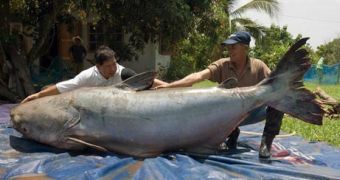You may associate a catfish with going fishing in a pond. But a new research has found that a species of Southeast Asian catfish, Pangasius krempfi, is anadromous: it moves from coastal waters into rivers to spawn, just like salmons do, in an over 600 mi (1,000 km) journey from the South China Sea into the Mekong River.
"This is similar to many salmon species that spend the first part of their lives at sea and then migrate hundreds-or even thousands-of miles up coastal rivers to spawn," said co-author Zeb Hogan, a fisheries biologist with the University of Nevada in Reno.
"The findings show that catfish are not "inactive dullards" after all. It certainly should change the way the general public looks at catfish," said Heok Hee Ng, a fish biologist at the National University of Singapore, not involved in this research.
This finding points to the fact that perhaps other catfish species all over the world may be anadromous, but also that a proposed hydroelectric dam on the Mekong in Laos could impact deeply the populations of catfish species in the Mekong river.
"There is clear evidence that Hou Sahong-the proposed site for the Khone Falls dam-is a major corridor for migratory fish and one of the worst possible locations in the entire basin to build a dam," said Hogan.
Over 2,000 species of catfish species dwell in rivers, streams and lakes, including some of the rivers' giants and smallest freshwater fish on the planet, even parasitic fish, like candiru of the Amazon basin, that enter the humans' genitalia.
"Many catfish species are believed to be migratory, but they live in murky rivers, making documentation of their movements difficult. We did suspect that Pangasius krempfi was anadromous, because fishermen reported the species in the South China Sea and far up the Mekong. The challenge was to connect the dots-to show that the fish from the South China Sea and the Mekong were part of the same population." said Hogan.
The team investigated isotopes in bone and muscles of catfish from the Khone Falls region of the Mekong, finding proof that the fish had just migrated from a sea environment.
"As far as I know ? this is the first record of a riverine catfish migration between marine and freshwater habitats based on radioisotope evidence. This is a highly regarded method, so I would say the finding is sound. ? [O]ne hopes now that catch data will confirm the presence of Pangasius krempfi in seawater." said John Lundberg, curator of fish in the department of ichthyology at the Academy of Natural Sciences in Philadelphia, Pennsylvania.
"The fact that these large catfishes have been fished for hundreds of years, and yet it is only recently that we know that these are anadromous, shows how little we know about the biology of many of these catfish species." added Ng.
Amongst P. krempfi's closest relatives are the Mekong giant catfish, regarded as the largest freshwater fish (up to 3m (10 ft) long and 300 kg (660 pounds)) and the giant "dog-eating" catfish, due to its appetite for canine carcasses.
P. krempfi is a dwarf compared with them at just 4 feet (1.2 meters) length, but appreciated as food: in Vietnam it is the main ingredient in a national soup.
Migratory fish are more vulnerable to extinction, as they require a variety of habitats for feeding and breeding and are easy targets during spawning migrations.
The P. krempfi's spawning would be impaired by the future dam at Khone Falls, as over 98 % of the individuals caught annually in the area are captured between mid-May and June, when they go upstream to spawn, once a year.
"Plans for a dam on the mainstream Mekong threaten migratory fish, which in turn threatens the livelihoods of the millions of people in the Mekong that depend on fish for food." said Hogan.
"The study highlights the need for all six countries that contain the Mekong to cooperate on protecting the river and its wildlife." said co-author Ian Baird, at the University of British Columbia in Vancouver.

 14 DAY TRIAL //
14 DAY TRIAL // 
